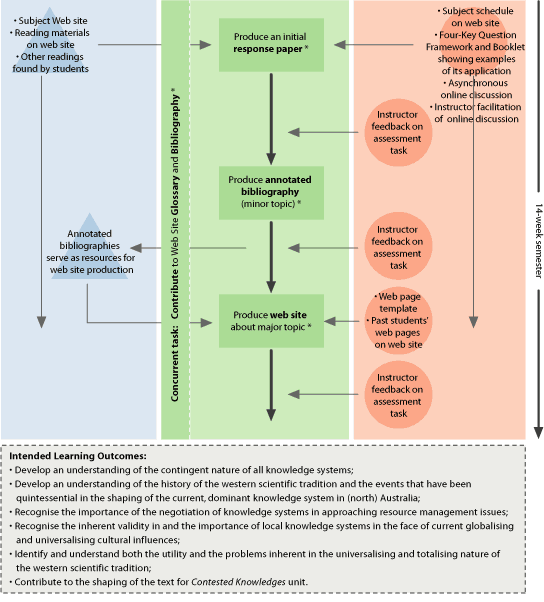|
WHAT THE STUDENTS DO
The learning experience is driven by the four individually-based
assessment tasks and it is expected that the learners are
active participants by contributing to the online discussions.
The learning tasks follow this sequence:
- Each student is firstly required to produce an initial
response paper to an assigned reading and is to incorporate
online postings made about this paper in their essay.
- The students then engage in a minor topic by searching
for relevant resources about a designated topic. They are
to post these in the online discussion. Each student’s
work serves as input to the next task for another student.
That is, someone’s minor topic becomes resources to
be examined by another students for their major topic.
- Each student produces a web site.
- A concurrent task that occurs throughout the subject is
the contribution to the glossary and bibliography.
Students are encouraged to participate in the construction
of knowledge and actively pursue the negotiation of what knowledge
is constructed and how this is done.
In the online setting students can choose to begin this journey
in one of two ways:
- Students can either explore the four central questions
that are introduced online but elaborated in print. that
is: What is at stake?, What is the status quo?, What are
the alternatives?, What happens when different knowledges
speak to each other?, or
- Students can explore the issue presented on the web site,
Wilderness, that introduces the four central questions in
relation to a specific context.
Students can then explore any of the other issues in any
order they choose. All issues are introduced through the four
central questions (which serves as a scaffold to assist students
when examining the literature). The issue of "Wilderness"
is the only one that has a visual interface on the web site.
(It is intended that all issues will be introduced using
a similar visual stimulus in the subject web site.)
SIGNIFICANCE OF ORDER
There was much conversation about this in the design phase
of the materials about this. We wanted students to experience
an actual site of contestation, for example, like the Wilderness
which would be within every students’ experience as well
as the issue of stereotypical concepts from a white western
paradigm.
However, to really understand how it could be contested,
students needed to understand the key questions that were
being asked. To resolve the issue, we have provided screen
prompts on the subject web stie about where we recommend the
students begin. But the choice is ultimately up to the students.
We have found though, that this guided approach has worked
well to date.
CRITICAL ACTIVITIES
Because the understanding of different knowledge systems provides
different perspectives on issues, the activities have been
designed to build this understanding. It is doubtful that
some tasks could be optional, however some could be explicitly
more collaborative.
|
